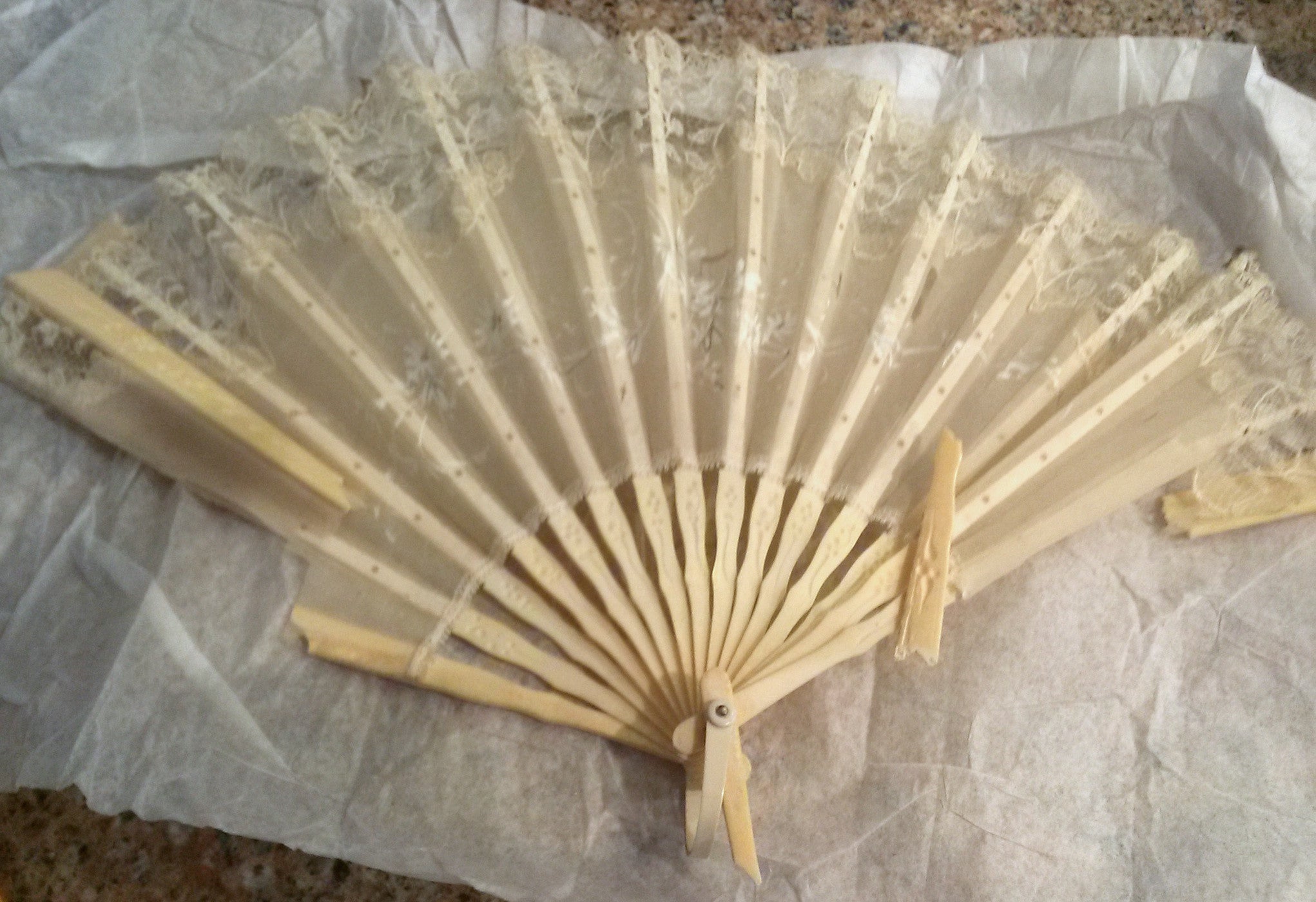
Repairing a Vintage Hand Fan
I purchased this celluloid-and-silk hand fan on eBay from the original owner's daughter. It was a real bargain, and in near-perfect condition with only a single, tiny tear in the silk. Here's one of the listing photos:
To save a couple dollars on postage (which I would gladly have paid) the seller opted to wrap the fan in a single piece of tissue paper and toss it into a padded envelope.
Before I'd opened the package, I knew. I could feel and hear loose bits shaking around. I hoped I was wrong. I wasn't.

The shards had torn through the silk in several spots of nearly every section. Some were hanging from one edge. Others had completely detached. Sob.

I emailed the seller who refunded my money and told me to give it a proper burial. I said I would. And maybe I should have, but I just couldn't. I had to try to save it. Such a lovely old thing.
I'd successfully repaired the antique fan I use for mid-Victorian dancing following Kat's instructions. But it had had only a few tears in the silk, which I'd reinforced with ultra-fine silk tulle purchased from the lovely proprietress at Mary, Not Martha on Etsy.
That tulle was expensive, and I use it sparingly for only the most deserving projects. This new fan was such a disaster, I wasn't sure I could fix it. I needed something delicate enough to give a good result, but not so costly that I'd regret trying if I failed. I went back to the shop and bought a remnant of off-white, nylon, fine English net. Not dirt cheap, but far less than the silk.
With the fabric en route, I started repairing each break in the celluloid using extra-thick tacky glue.
Because of how a fan is shaped, it's very difficult to work on more than one small area at a time. You have to move slowly, letting each section dry before moving on. If you're like me, you'd best distract yourself with another project during the dry time or risk undoing what you've done (or causing more harm).

Don't look at the tulle, please. We're not up to that yet. Just look at the glued end piece. Yes, I know, it's far from perfect -- it flat-out refused to align properly -- but it's intact.
Each of the thin, balsa wood ribs had snapped. Because they're so narrow, and the decorative perforations leave little to reconnect, they were repair-resistant, remaining bendy and vulnerable no matter how many layers of glue I added. Kat suggested using painted wooden coffee stirrers as splints (she's always coming up with creative solutions). If the fan doesn't hold up, I will give that a try.
Just look at the damage to the silk.

Tulle time!
Here's what you do.
First, open the fan as much as possible. Lay your tulle over it and cut a piece large enough to cover the silk completely, leaving about an inch overlap all around. This will be a bigger piece than you'd think, due to the curvature. This photo shows the front of the fan, but you'll apply the tulle to the back.

Squeeze some white school glue (Elmer's or similar) into a small bowl and add water to thin it a bit. You'll want to use a non-shedding artist's brush to apply the glue. Here's my set-up. I work on parchment or wax paper to prevent sticking.

Working on the back, brush glue onto and through the tulle at the last rib, then onto the tulle between the ribs. I did about five sections at a time. Flip the fan over and repeat the process for this first set on the front, brushing the glue directly onto the silk and through to the tulle. Wet silk likes to rumple up, forming bubbles and creases. It can be frustrating. Just work them out as best you can and enjoy the process. It's fun if you don't stress.
Move the wet fan to a dry spot on your work surface and then step away and go do something else for about 20 minutes.
When the glue is almost, but not quite, dry, gently fold the newly glued section. This is important, as you don't want your fan to be glued in the open position permanently. But avoid leaving it folded or you'll have the opposite problem. You're just sort of "training it to fold," as Kat puts it. Gently unfold it until it's fully dried.
Continue the process of gluing, almost-drying, and temporarily folding, until the entire fan is backed with tulle and the silk is reattached as smoothly and completely as you can get it. Glue any broken-off bits and pieces wherever they seem to fit. There may be gaps, depending on the extent of the damage.
So long as the silk has the tulle backing to hang onto, you'll have a functional fan and the flaws won't show except on close inspection.
When the fan has dried completely, trim away the excess tulle, then fold it up. I tied a ribbon around it because even fine tulle adds bulk, and this helps compress it a bit.

Here is the repaired fan. You can see that it's a bit rumply and a few ribs are slightly crooked. If it collapses with use, I'll give the coffee-stirrer solution a go. Still, I'm pleased with the result. Much better than the fan graveyard. Don't you agree?


Silk chiffon might be a less-bulky alternative backing, although tulle offers the benefit of being nearly invisible and not interfering with the translucence of the silk. If you've used chiffon or another material with good success, please let us know in the comments.

Comments
Amazingly done! So impressive. So glad you gave repair a try….. I probably would have cried and tossed.
Make do and mend! You are obviously a woman with patience and fine motor skills—just the kind of woman who would be good at wallpapering.
Thanks so much for this wonderful tutorial, Liza! Almost makes me want to buy an antique fan just to try it out… almost.
I would definitely suggest tulle over chiffon for the most transparency possible. And a good note to request something so delicate be shipped in more protective packaging, most certainly….
Kudos to you for saving this lovely antique fan!
Great job! I admire your patience.
You did a beautiful job! Your care and patience is amazing, and it’s wonderful to see such a lovely and delicate fan brought back to ‘life’.
I am in the process of repairing an old fan that was recently given to me, now that I have this information I have less fear.
Thank you, thank you,thank you so much!
GOD Bless you!
Sharon Johnson
Thank you so much for this tutorial! I found you thru my InstaGram feed. I am finding rethreading the ribbons thru my fans is not as simple a repair as one would assume, try as I might to follow the lengths and spacing still visible from the remnants of the originals. Any suggestions would be appreciated!
Also, based on your close up of the ribs, I believe the bottom ring is celluloid, but the ribs are bone. The striations and tiny holes for blood vessels distinquish it from ivory, and the its matt surface is not usually the finish used on celluloid. I may be wrong of course…but I think bone would probably indicate an older fan.
Hi, We are looking for a place to restore a hand-held fan – I saw the article about restoring a fan on your website – I do not know if you offer this service or if it was one of your customers that uploaded the info. If you do offer this service could you let me know? Many thanks, Terry and Barb Flannery
Hi, Terry and Barb. I’m the only one (so far) who writes these posts, and it is definitely my repair work on the fan. I don’t know that I’m qualified to fix your fan, but I’d be willing to give it a try if you’re willing to go with a non-pro with a lot of patience! Please email me photos so I can see what sort of condition your fan is in. If I think I can fix it, we can discuss the cost and other details. Thanks for reading and for visiting Better Dresses Vintage. – Liza (info@betterdressesvintage.com)
Would you know of any people who repair fans……please.
I’m not even sure if this fan is ivory but I would like to repair it if possible.
Thank you …
Hi, Robin — I don’t know of anyone who repairs fans professionally as a business. Perhaps a local antiques shop could point you to someone in your area.
As I told Terry and Barb, I’m certainly willing to give it a try. If you send photos we can discuss the options.
But I’d suggest you follow the above steps and give it a go yourself. With some patience and a gentle touch, you will likely have excellent results. Best of luck!
How would you recommend we repair the end ring (where it hangs). I have a couple of fans where they ring as broken off.
Thanks so much
Diana
Diana, hello, and thanks for reading the blog. I haven’t had to replace a broken end ring, but there must be replacements available. I’d check wholesale suppliers (maybe on Etsy or eBay) or perhaps scavenge them off other fans that are beyond repair.
For my fans without a ring, I’ve simply threaded the hanging ribbon (silk, very slim) between the slats and it works fine.
Hi, there’s actually an entire organization dedicated to fans! You can contact the Fan Association of North America for help and advice on collecting and saving hand fans. They can also point you in the direction of professional fan restorers, if you don’t want to tackle a repair yourself. Their website is fanassociation.org .
Thanks for sharing a valuable info author,Loved it and fixed my vintage fan and now I m really happy after fixing my golden hand fan and also we make hand fans for sale will share this with my office staffs and make them to understand on fixing the vintage fans.Since we had many vintage fans in a repaired condition now after understanding the steps it made us to fix the vintage fans easily.Loved it !!! Thank you once again.
Thank goodness I found your site!! I have a WW2 Japanese Silk hand paddle fan that my godfather sent my mother, while serving in Japan after its surrender. For over seventy years the fan has been well caried for, but now there are small tears in it. I thought it would be unrepairable but thanks to your tulle idea the fan will have another decade or two of life. Thank you!😂😁
Edna, thank you for you comment. I’m so glad to be able, in even a small way, to help save your historic fan! Let us know how the repairs turn out!

